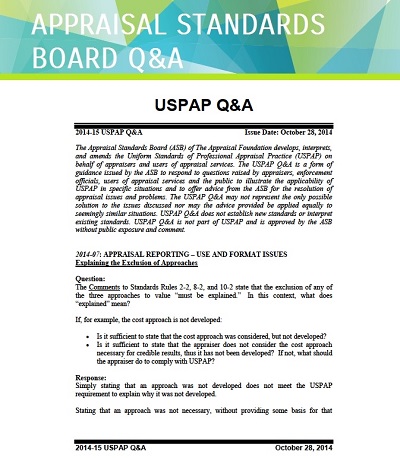The Appraisal Standards Board just released a new Q&A on the confidentiality of physical characteristics and reasonable steps to safeguard and protect confidential information and content. This rule applies to all of the disciplines, but as the Appraisal Foundation has become more involved with and understand of personal property appraising, they realize the importance of publishing personal property specific examples. I commend the AF for their hard work and effort in incorporating more personal property relevant examples in their standards and reference materials.
Speaking of a better establishing and growing working relationships with the Appraisal Foundation, on Friday I will be involved in an Appraisal Foundation sponsored personal property collaboration meeting. Representatives from the TAFAC Special Issues Committee,The Personal Property Resource Panel, and Consumer Affairs and Stakeholder Outreach Committee will discuss ways to the to further promote professional societies, qualifications and USPAP. Pretty cool stuff, and hopefully something that will pay dividends to appraisers, sponsoring personal property orgs and the AF.
Back to the USPAA Q&As, all personal property appraisers should read the following ethics rule on confidentiality for dealing with physical characteristics and to read the reasonable steps to protect and safeguard confidential information.
The ASB reports
Source: The Appraisal Foundation2016-06: ETHICS RULE - CONFIDENTIALITY
Physical Characteristics or Assignment Results – Fine Art Example
Question:
Last year I appraised a painting that was subsequently sold by an auction house. My client was the owner of the painting. A fellow appraiser, who is now appraising a similar painting by the same artist, recently contacted me. This other appraiser is using the painting I appraised as a comparable example and has asked me several questions about its physical condition. I would like to help this colleague but want to be sure that I am not violating the Confidentiality section of the ETHICS RULE. My client did not request that I keep the condition report prepared by the auction house confidential, and I still have it in my workfile.
May I share the auction house condition report?
Response:
Yes. Even though the condition report includes opinions about the subject painting’s condition, they are the opinions of the auction house, not of the appraiser. Therefore, they are not assignment results as defined in USPAP.
To meet the USPAP definition of confidential information, the information must be both identified by the client as confidential, and not available from another source. The auction house condition report was not identified by the client as confidential, and it also may still be available from another source (directly from the auction house). So sharing the auction house’s condition report is not a violation.
It should be noted that an appraiser’s own opinion as to the condition of the painting would qualify as assignment results under USPAP and, therefore, could not be disclosed without permission from the appraiser’s client.
2016-07: ETHICS RULE - CONFIDENTIALITY
What are “Reasonable Steps”?
Question:
USPAP now requires that an appraiser “take reasonable steps to safeguard access to confidential information.” What are reasonable steps?
Response:
The Confidentiality section of the ETHICS RULE stipulates that except in certain circumstances, the appraiser must not disclose confidential information or assignment results (both as defined in USPAP). Safeguarding confidential information and assignment results requires the appraiser to make a decision as to what is reasonable. One dictionary defines reasonable as being based in sound judgment. Sound judgment is
not a one-size-fits-all proposition. For example, what are reasonable steps for an appraiser who is working in a public space where others might be able to see the work papers or computer screen? The reasonable steps necessary to safeguard private documents from public view could vary.
The same judgment extends to the appraiser's office. It is up to the appraiser to determine when confidential information and assignment results should be kept under lock and key or in a closed folder. The answer could vary depending on the office environment;
reasonable steps for an appraiser working from a home office might be different from those required in a large firm with appraisers and others having access to the workspace. USPAP requires an appraiser to exercise good judgment; it does not list steps the appraiser should take to comply.
Confidential information and assignment results can also be stored electronically. This information kept in desktop computers can be safeguarded in the same manner as physical files. The information can also be kept on an array of portable devices (e.g.,laptops, external disk drives, small flash drives, smart phones, etc.). These devices may be easily misplaced, lost or stolen. The loss of one of these devices carries the same risk as orally disclosing confidential information or misplacing printed copies of reports.
USPAP cannot specify the steps an appraiser should take to prevent losing these devices or documents, nor can it specify what to do if that happens. Over time, new data storage and security technologies will evolve. USPAP does not specify whether these devices must be encrypted or password protected, nor the level of protection. USPAP cannot specify whether the appraiser must have the ability to remotely erase confidential
information.
USPAP can only require the appraiser to exercise sound judgment. Therefore, relying on best professional practices, individual appraisers must seek “reasonable” and practical solutions to maintaining client confidentiality.



No comments:
Post a Comment